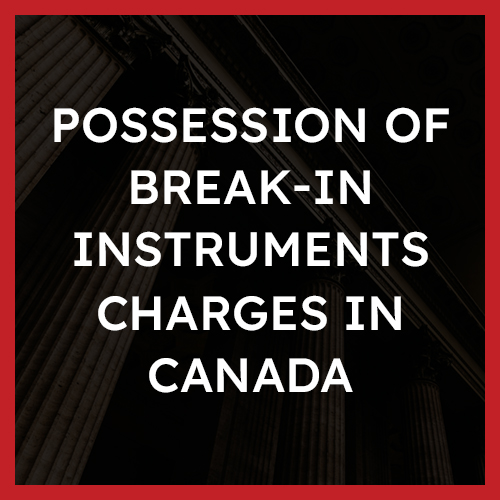Possession of Break-In Instruments (s. 351) Laws in Canada
What is a Possession of Break-In Instruments charge?

It is a criminal offence to possess these instruments with the intention to use them for a criminal purpose, such as breaking into a building or stealing property. The offence does not require proof of an actual break-in, only that the accused intended to commit an offence.
Possession of such break-in instruments is a separate offence from a breaking and entering charge or an attempted breaking and entering charge. The possession offence can be charged independently or in addition to other offences related to breaking and entering
Examples
- A search of a suspect’s home reveals various lock picks, crowbars, and other burglary tools, along with a notebook filled with sketches of local businesses’ layouts.
- A person is pulled over by police while driving and found to have a ski mask, gloves, and a crowbar in their trunk. They explain that they are a locksmith, but don’t have a good reason as to why they have them in their car.
- A group of teenagers were found loitering outside a store at night with a bag of tools, including a screwdriver, pliers, and a hammer. They claim they are just “hanging out,” but police think they may be planning to break in.
Defences
If someone is charged with possession of break-in instruments, they may use one or more of the following defences:
- Innocent Possession: The defendant may argue that they did not have the intention to use the break-in instruments for any unlawful purpose. They may show that they had the items for a legal purpose, such as for their lock-picking business.
- Lack of Knowledge: The defendant may argue that they were unaware that they possessed break-in instruments or that they did not know that such items were illegal to possess.
- Unlawful Search and Seizure: The defendant may challenge the search and seizure of the break-in instruments by arguing that the police did not have a lawful reason to search or seize the items in question. If so, the evidence obtained may be excluded.
- Duress: For a defence of duress to be successful, the accused must prove that they committed the offence because they were under an immediate threat of death or serious bodily harm. There also must not have been any other reasonable way for them to avoid the threat other than by committing the offence.
Punishments
Possessing break-in instruments is a criminal offence that is punishable under Section 351 of the Criminal Code. This section prohibits the possession of any tool or instrument that is intended to be used for the purpose of breaking into a place, such as a house or a vehicle.
If a person is found guilty of possessing break-in instruments, the punishment can vary depending on the circumstances of the offence. If the Crown prosecutes the case by indictment, the maximum penalty is imprisonment for up to 10 years. If the Crown prosecutes the case by summary conviction, the maximum penalty is imprisonment for up to 18 months, a fine of up to $5,000, or both. The Criminal Code also allows for increased sentences for repeat offenders or those who use break-in instruments to commit an actual break-in.
Overview of the Offence
Section 351 of the Criminal Code states:
351(1) Every one who, without lawful excuse, the proof of which lies on them, has in their possession any instrument suitable for the purpose of breaking into any place, motor vehicle, vault or safe under circumstances that give rise to a reasonable inference that the instrument has been used or is or was intended to be used for such a purpose, (a) is guilty of an indictable offence and liable to imprisonment for a term not exceeding ten years; or (b) is guilty of an offence punishable on summary conviction
The Guilty Act (Actus Reus)
The actus reus (physical aspect) of Possession of Break-in Instruments involves having any item that could be used to commit a break-in or a theft offence. Section 351 defines “break-in instrument” as any tool, instrument, or other thing that is capable of being used to break into any place, receptacle, or device with the intent to commit an offence.
To establish the actus reus of possession of break-in instruments, the Crown must prove:
- Possession: The accused must have physical control over the instrument. This may involve having the instrument on their person, in their vehicle, or in their home.
- Knowledge or Control: The accused must know that they possess the instrument or have control over them. Another way the Crown can prove knowledge is to prove the accused was willfully blind to the fact that they possess the instrument. To be willfully blind means to purposefully avoid learning the truth about the possession of the instrument. If this is established, the knowledge requirement of the actus reus is satisfied.
The Guilty Mind (Mens Rea)
The mens rea of Possession of Break-in Instruments refers to the intent (mental element) required for someone to be found criminally liable for possessing break-in instruments. This mental element is essential to any criminal offence and must be proven by the Crown beyond a reasonable doubt.
To establish the mens rea of possession of break-in instruments, the Crown has to prove that the accused had the knowledge and intent when they possessed the instrument.
More specifically, the Crown must prove the following elements:
- Knowledge: The accused must have known that they possessed the break-in instrument. This means that they must have been aware of the nature and characteristics of the instrument and that it could be used to commit a break-in or theft offence.
- Intention: The accused must have possessed the instrument with the intention to use it to commit a break-in or theft offence. This means that they must have had a specific purpose for possessing the instrument, which was to use it to commit an offence.
The intention can be inferred by the specific circumstances of the case. For example, if the accused possesses a set of lock picks and is found outside a closed shop in the middle of the night, it may be reasonable to infer that their intention was to use the lock picks to commit a break-in.
The mens rea is determined subjectively, meaning it is the accused’s actual knowledge and intent that is relevant, not what a reasonable person would have known or intended in the same circumstances. Put differently, even if a reasonable person in the same circumstances would not have known or intended to use the instrument to commit an offence, the accused can still be held criminally liable if they had the requisite knowledge and intent.
Defences
There are several possible defences that an accused person may use to fight a charge of possession of break-in instruments under Section 351 of the Canadian Criminal Code. However, the availability and success of these defences will depend on the specific circumstances of each case. Some of the most common defences include:
An expanded version of the summarized content in the introduction
- Innocent Possession: This defence is based on the idea that the accused didn’t have the intention to use the break-in instruments for any unlawful purpose. It may be applicable in instances where the accused had the tools for an acceptable reason, such as if they were a locksmith who had lock-picking tools to help customers who locked themselves out of their homes. For this defence to be used, the accused has to establish they did not intend to use the instruments for an unlawful purpose and that they had the items for legitimate reasons.
- Lack of Knowledge: The defence of lack of knowledge asserts that the defendant was unaware that they possessed break-in instruments or that they did not know that such items were illegal to possess. This defence may be viable in cases where the defendant was given the tools by someone else or received them without knowing that they were illegal. To use this defence, the defendant must be able to show that they weren’t aware of the illegal nature of the items and that they did not intend to use them illegally.
- Unlawful Search and Seizure: If the police did not have a lawful reason to search or seize the break-in items, this may constitute an unlawful search and seizure. If the accused can prove that this was the case, the evidence obtained may be excluded due to a violation of their Chart of Rights and Freedoms. This defence is particularly relevant in cases where the police did not have a warrant or did not have probable cause to conduct the search.
- Duress: In order for a defence of duress to be successful, the accused must prove that they committed the offence because they were under an immediate threat of death or serious bodily harm. There also must not have been any other reasonable way for them to avoid the threat other than by committing the offence. They also have to show that they did not willingly participate in the offence, but did so under the compulsion of the threat.
Punishments
The penalties for possessing break-in instruments can vary depending on the circumstances of the offence. Section 351 is considered a hybrid offence, which means that it can be prosecuted either by way of summary conviction or by way of indictment, depending on the severity of the offence.
If the Crown prosecutes the case by way of indictment, which is the more serious option, the maximum penalty is imprisonment for up to 10 years. If the Crown prosecutes the case by way of summary conviction, which is a less serious option, the maximum penalty is imprisonment for up to 18 months, a fine of up to $5,000, or both.
The Criminal Code also allows for increased sentences for repeat offenders or those who use the break-in instruments to commit an actual break-in. For example, if a person is found to have used the tools in the commission of a break-in, they may face a longer prison sentence than if they had only been caught with the tools in their possession.
In addition to these criminal penalties, a conviction for possessing break-in instruments can also have other serious consequences, such as a criminal record, trouble finding a job, and difficulty travelling to certain countries.
Frequently Asked Questions
What is the punishment for Possession of Break-in Instruments?
The punishment for possession of break-in instruments varies depending on the circumstances of the offence. Generally, if the accused is found guilty of possessing break-in instruments, they could face imprisonment for up to 10 years, provided the Crown prosecutes it by way of indictment. If the Crown prosecutes the case by summary conviction though, the maximum penalty is imprisonment for up to 18 months, a fine of up to $5,000, or both.
Can you go to jail for Possession of Break-in Instruments?
Yes, a sentence of jail time for possession of break-in instruments is possible. The likelihood of going to jail for this offence depends on several factors though, including the severity of the offence, criminal history, and the judge’s discretion.
By and large, if the offender doesn’t have a prior criminal history and there aren’t any aggravating circumstances, such as evidence of an intended break-in or possession of other illegal items, they may be more likely to receive a reduced sentence. This could include paying a fine or doing community service work. This being said, if the offender has a prior criminal record or there are aggravating circumstances, they may be more likely to receive a harsher sentence, like jail time.
What’s the difference between break and enter and home invasion?
A “Break and enter” is when a person forcibly enters someone else’s property with the intention of committing a non-violent crime, such as theft, vandalism, or assault. The “break” aspect of this offence refers to the use of force to gain entry, which can involve breaking a window, picking a lock, or removing a door.
On the other hand, a home invasion is deemed to be a more serious offence that occurs when a person goes into someone else’s property with the intention of committing a violent crime, such as assault, robbery, or sexual assault against the occupants. This differs from a break and enter in the way that a home invasion involves a direct confrontation between the offender and the occupants of the home, which can lead to physical harm or death.
Published Decisions
R v Nelson, 2020 BCCA 204 (CanLII)
After the serious crash of a stolen vehicle containing various illicit items, the appellant, who was also the driver, left the scene after the crash, leaving a passenger trapped in the vehicle. He appealed his convictions for various offences including that of possession of break-in instruments.
The judge did not provide sufficient justification for the conviction regarding the possession of break-in instruments charge and the evidence presented was insufficient to support this conviction. As such, the appeal was granted and his conviction of possession of break-in instruments was overturned and he was declared not guilty of that charge.
You can read the full decision here.
R v Brimner, 2016 ABCA 349 (CanLII)
The accused was charged with possession of break-in instruments as well as breaking and entering with theft of over $5000 and possession of stolen property. He had a lengthy criminal record with 30 convictions for offences similar to this. He testified that it was all done to make money to sustain his drug addiction.
The sentencing judge was not lenient on his sentencing for the possession of break-in instruments given his lengthy criminal record, despite him being sober from the drugs. His guilty plea was also given relatively little weight as he entered it the morning of the trial. On appeal though, the Court found his sentence to be too harsh and it was reduced from 28 months to 15.
You can read the full decision here.
R. v. R.T.S., 2006 NBCA 65 (CanLII)
In this case, the accused was heavily addicted to opioids and had a lengthy criminal record. On July 12, 2005, the accused was found in possession of break-in instruments. These included bolt cutters, a crowbar, pliers and a chisel. This occurred while he was on probation.
Despite his lengthy criminal record, the Court considered that none of his prior convictions exceeded 2 years and that all of his crimes were property based or due to a breach of probation (non-violent). The Court also considered the relevant circumstances of his case being if he was sentenced to more than 1 year, he may qualify to be admitted into the methadone treatment program, in the interest of rehabilitation. As such, he was sentenced to 20 months in jail.
You can read the full decision here.
About The Author







